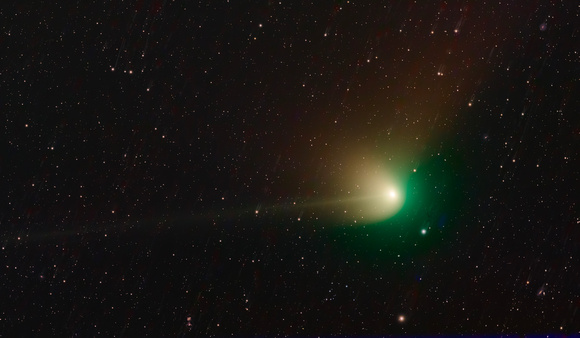The Green Comet II (C/2022 E3 ZTF)
The Green Comet (C/2022 E3 ZTF) version 2
Comet C/2002 E3 (ZTF) in RGB - Jan 30th 2023
Televue 127is - AIS6200MC A-P 1100 GTO AE
Antlia v-Pro LRGB filters
Lum:
(25 x 30s exposures, Bin 1x1, Gain 100)
(73 x 8s exposures, Bin 1x1, Gain 100)
RGB:
(3 x 12 x 30s exposures, Bin 1x1, Gain 100)
( 3 x 25 x 8s exposures. Bin 1x1. Gain 100)
Total Integration Time = 0.84 hours
(note 120 second exposures were taken, but not used)
Comet C/2022 E3 (ZTF) was discovered in March 2022 at the Zwicky Transient Facility. It reached perihelion on January 12 (1.11 AU), 2023 and was closet to the earth (0.28 AU) on Feb 1.
The colour is due largely due to the concentration of C2 (diatomic carbon) which is chemically unstable on earth. Diatomic carbon vapour undergoes photolysis (disassociation of the carbon atom, after being hit by photons) and only exists for a couple of days before degradation. This is why the green appears near the head of the comet, but disappears in the tail.
Thanks to the Luminance filter exposures, faster telescope, and wider field employed in this image version, the long faint ion tail and the faint reddish tail (away from the sun) are both visible. Apparently there is a third tail on this comet, that escapes me and apparently, the image.
Tracking of the comet was done using NINA's Orbital add-in, which also uses JPL's Horizon data. However, my lack of familiarity with Orbital and maybe a less precise all-sky model led to issues with framing the comet AND it had a little bit of drift in the image (fixed through cropping). I am sure that once I figure out Orbital in NINA for myself, it will perform just as well as my mount-native Horizons utility.
I struggled to keep the star trails (due to tracking the comet) out of the final image and I am still thinking of a better way to do this. Again, being greedy, I manually put the galaxies I spotted back in the image. Artifacts due to these two processes make this image a little "dirty".


